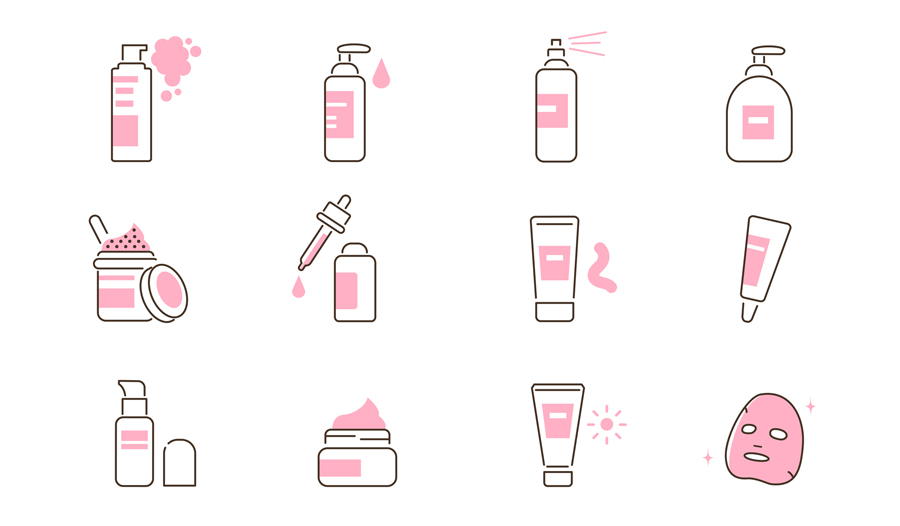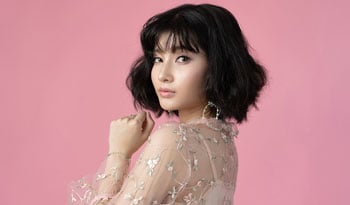iHerb Beauty’s Guide to J-Beauty
DISCLAIMER:This blog does not intend to provide diagnosis...
- In this article:
- How is J-Beauty Different from What We Know?
- How Does J-Beauty Differ from K-Beauty?
- The Perfect Daily J-Beauty Routine
- Weekly Steps to Enhance Your J-Beauty Routine
- Will J-Beauty Help You Reach Your Skin Care Goals?

For several years now, Korean beauty—also known as K-beauty—has been all the rage. It seems that Asian skincare is here to stay, and not because it's fun and kitschy, but because it's genuinely effective. If you prefer your skincare to be more straightforward than the popular 10-step K-beauty process but still want to try something new, you may want to look at another letter of the alphabet: J.
That's right. J-beauty (or Japanese beauty) could very well be the Asian skincare regimen for you. You may have even unknowingly used some Japanese beauty products before. Did you know that double cleansing, sheet masks, and essences actually originated in Japan? Some of the most popular cult-favorite skincare products on the market hail from Japan.
If you've heard about Japanese or J-beauty and wondered what the heck it is, how it's different from K-beauty, and what the benefits are, look no further. Today we're going to take a deep dive into J-beauty so you can decide if you're ready to incorporate this skincare philosophy into your beauty life.
How is J-Beauty Different from What We Know?
The Japanese skincare philosophy centers around a proactive rather than a reactive approach. The main goal of J-beauty is to nourish the skin, so it becomes naturally luminous, soft, radiant, hydrated, and healthy. An effortlessly natural glow is what a J-beauty routine is all about.
Most of us are already familiar with the basics of a J-beauty skincare regimen: cleansing, toning, and moisturizing the skin. But if you want that glow, according to J-beauty, you must take things a few steps further.
The basic daily steps of a J-Beauty skincare routine consist of double cleansing, hydrating with an essence or lotion, treating with a serum, and moisturizing the skin. Sun protection, exfoliation, and periodic masking are also components of this beneficial routine.
While most of us here in the West are used to slathering on a thick layer of moisturizer or cream, Japanese beauty is all about using light serums, lotions, emulsions, gels, and milks that are absorbed into the skin very easily. With their thin textures, these products also layer easily with one another and don't feel heavy on the skin.
How Does J-Beauty Differ from K-Beauty?
K-beauty may have taken the western world by storm with its trendy packaging and numerous skincare steps, but J-beauty is a refreshing change for those of us who prefer more streamlined, curated routines.
Both J-beauty and K-beauty focus on clear, luminous skin, hydration, and the importance of sunscreen. However, there are numerous key differences between the two.
K-Beauty
K-beauty places great focus on instant results, brightly colored packaging, gimmicks, trends, and unusual ingredients (snail mucin, anyone?). Probably best known for their extensive multi-step skincare regimen, simplicity is not part of the game here. The end goal of a K-beauty routine is to hydrate thoroughly and achieve “glass skin”—skin that is poreless, luminous, and translucent.
A K-beauty regimen is typically a 10-step process but can include as many as 15 steps (or as little as 5 steps if you're genuinely trying to streamline). No matter how many steps are involved, a typical K-beauty routine includes three things:
- Essences actually originated in Japan but have gained popularity due of K-beauty. An essence is an extremely light watery fluid that provides intense hydration while prepping the skin so that the products applied on top are absorbed more readily. We’ll talk more about essences down below.
- Ampoules typically contain a high concentration of active ingredients and are known to be even more potent than serums.
- Sheet masks galore! I'm convinced part of K-beauty's rise is mainly due in part to the popularity of sheet masks. There are just as many brands as there are masks for every skin concern you can dream of.
If you're someone who enjoys having a skincare ritual and likes variety, fun packaging and playing with different textures and formulas, K-beauty would be a dream for you.
J-Beauty
Japanese beauty is much more straightforward, simplified, and refined. Forget the gimmicks, the bright, playful colors, and most notably, the 10-15 steps. J-beauty is in it for the long haul by using science and technology to produce noticeable results.
J-beauty focuses on a more simplified design aesthetic and utilizes only a few deliberate steps that involve multitasking products to provide maximum efficacy. This curated skincare regimen is designed to give you precisely what you need with no fluff.
As opposed to “glass skin,” the goal of a J-beauty routine is “mochi skin,” with a plump, supple and smooth texture, without a hint of dryness.
A basic Japanese beauty regimen includes:
- A lotion or essence which is patted into the skin. These provide intense, non-greasy hydration through the use of natural ingredients. Their watery texture allows them to penetrate the skin deeply.
- While SPF is a vital ingredient in both K-beauty and J-beauty, Japan is known for its advanced sunscreen formulations.
- Oils are abundant in Japanese skincare. They’re used to both remove makeup during the double cleansing process and to moisturize the skin.
As a multi-tasker myself, I appreciate the beauty and simplicity of a J-beauty routine for the busy woman.
The Perfect Daily J-Beauty Routine
Follow these essential steps, and you'll be well on your way to beautiful, luminous, glowing skin.
Step 1: Double Cleansing
A significant component of Japanese beauty is double cleansing. Many Westerners incorporate double cleansing into their nightly routines without realizing its history. This cleansing ritual dates all the way back to the 14th century, when oil cleansers were necessary to remove the traditional, stubborn white base worn by Japanese women. A foaming cleanser was then used to remove any remaining oil residue.
With double cleansing, the first step is designed to gently remove what's on the skin without stripping the surface, leaving your skin bare. The second step removes dirt, oil, and clears out your pores so that skin is cleansed, prepped, and ready for the next skincare steps. Now let's talk about the double cleansing process and the products used.
The first step of double cleansing is removing your makeup with an oil cleanser. Balms can also be used for this step, though oil cleansers are more common.
One might think using a rich balm or oil cleanser might cause breakouts or clog pores. On the contrary, these products work to effectively remove excess oil, stubborn makeup, mascara (yes, even waterproof), and sunscreen while nourishing the skin at the same time.
Oil (or balm) cleansing is the first step of a Japanese beauty nighttime routine.
Once the oil or balm cleanser is rinsed off the skin with water, a gentle foaming cleanser is used to thoroughly cleanse the skin and prep it for the skincare steps to follow.
Due to this thorough yet gentle double cleansing process, many women find they can cleanse with only water in the morning. However, if you feel like water isn’t enough for you, cleansing with a gentle foaming cleanser is acceptable.
Step 2: Skin Conditioners
Skin conditioners in Japanese skincare are usually referred to as first essences or lotions. Much like toners, these are used as a post-cleansing step and also have a watery consistency. But that's where the similarities typically end. The main difference between Japanese lotion and western lotion (or what is commonly known as toners) is that these skin conditioners are never harsh and don't contain astringent properties. Many have no scent and feel like water when applied to the skin.
Japanese lotions and essences have beneficial ingredients that are designed to hydrate and soften the skin rather than strip the skin.
In fact, applying a skin conditioner before moisturizing the skin will increase skin elasticity and firmness. Because of the added water content, skin will also appear brighter and healthier. Many times, lotions and essences also have other advantageous skin conditioning and anti-aging properties. Common skin conditioner ingredients are aloe, hyaluronic acid, and ceramides.
Because of their consistency and ingredients, skin conditioners are more easily absorbed into the skin than other types of skincare products. They're also able to penetrate the skin more deeply and help prep the skin to more readily accept the products that will be applied on top.
Essences and lotions can be used morning and night and should be pressed or patted into the skin with your fingers rather than swiped across the surface with a cotton pad.
Step 3: Serums
Serums contain most of the beneficial vitamins and active ingredients that are applied to the skin and address specific skin concerns like fine lines, wrinkles, spots, dryness, or dullness. Serums are often confused with lotions and essences but are slightly thicker in consistency and usually have a higher concentration of active ingredients.
Step 4: Moisturizers
The focus of Japanese beauty is layering, so the skin isn't weighed down with heavy products. Instead of applying heavy creams, J-beauty uses gels, gel creams, milks, and emulsions to add moisture to the skin while sealing in the active ingredients and hydration underneath.
Step 5: Sunscreen
If there’s one skincare product Japan is most known for, it has to be sunscreen. Did you know that the UVA rating system was developed in Japan? That’s right! At one point in time, we only knew how much SPF (the UVB rating) a sunscreen contained. Thanks to advanced Japanese technology, we’re now able to see what level of UVA protection a sunscreen product provides by looking at its PA+ to PA++++ rating.
Japanese sunscreens are known for their fast-absorbing, effective, smooth, and non-sticky textures. Japanese women wear sunscreen daily, no matter where they're going or what they're doing, indoors or out. It only makes sense that Japanese sunscreens are cosmetically elegant with some of the best formulations in the world. If you haven't tried them, it might be time!
Weekly Steps to Enhance Your J-Beauty Routine
Some Japanese beauty rituals don't need to be done daily to be effective. Adding an extra step or two to your skincare regimen just once or twice a week can become a pampering treat and can improve your skin even further.
Exfoliators
You won't find harsh scrubs or tools in Japanese beauty. Many western scrubs contain ingredients like apricot shells or sugar, which can cause tiny invisible micro-tears in the skin. This is a big no-no in Japanese beauty where gentle is always better.
Instead, you'll find gels and gommages which provide gentle, soft exfoliation. Japanese exfoliators are applied to dry skin, where they bind to your facial oils and form small ball formations. As you massage and exfoliate, brighter, healthier skin is revealed.
Exfoliating once a week is plenty, although, those with oily/combo skin may want to exfoliate twice.
Lymphatic Massage
Practicing regular lymphatic massage can reduce the appearance of pores, puffiness, and wrinkles. It's also known to improve skin tone and circulation as well as increase skin elasticity, collagen levels, and of course, lymphatic drainage. This can be accomplished through the use of a facial roller or by massaging your face with your hands. Either way, you’re doing your face a huge favor!
Masking
Simple targeted sheet masks are a staple in any Japanese beauty routine. Think of masking as a weekly pampering treat. Feel free to try different masks to see what suits your needs at the moment.
Will J-Beauty Help You Reach Your Skin Care Goals?
Japanese beauty routines and products have yielded beautiful anti-aging and skin texture results for many years. So, if your goal is to have balanced, calm, hydrated skin so you can wear less makeup, it might just be the beauty regimen you need.
Depending on your current beauty routine, J-beauty may or may not take more time. You may not be ready to do a complete skincare overhaul. In that case, incorporating J-beauty products into your current routine can still make a huge difference in its clarity, appearance, and condition.
There's something to be said for a straightforward, streamlined skincare routine that's been in place for hundreds of years. When something works, it works. You only have to look at the gorgeous skin of Japanese women who’ve been putting J-beauty into practice for centuries. Hey, it’s worth a shot, right?

 By Stephanie Marie
By Stephanie Marie


